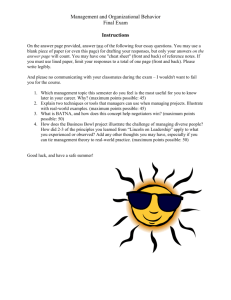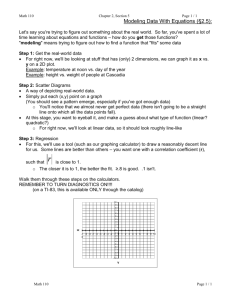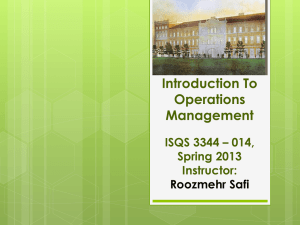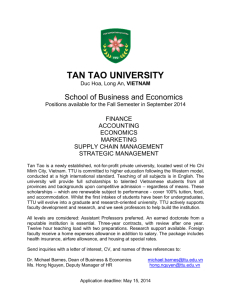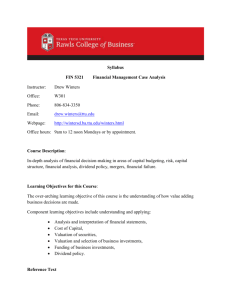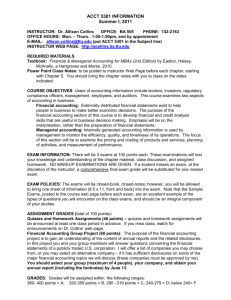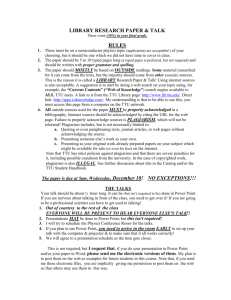EIME IDETC 2010 - TTU CAE Network
advertisement
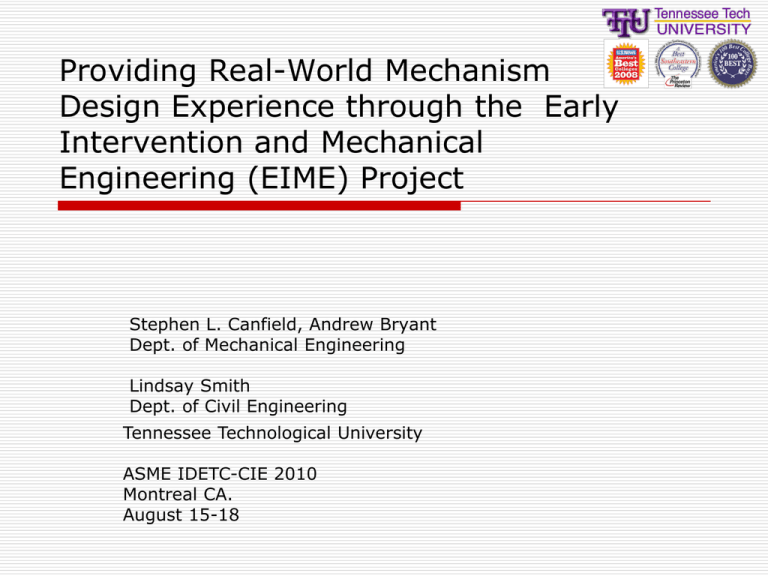
Providing Real-World Mechanism Design Experience through the Early Intervention and Mechanical Engineering (EIME) Project Stephen L. Canfield, Andrew Bryant Dept. of Mechanical Engineering Lindsay Smith Dept. of Civil Engineering Tennessee Technological University ASME IDETC-CIE 2010 Montreal CA. August 15-18 Outline of presentation Description of project Elements of education Pedagogical basis Stakeholders Expectations and outcomes per stakeholders Project Examples Pedagogical basis Over arching idea; learn by doing in a relevant, guided and motivational environment Problem-Based learning (Duch, 2001) Contextualized learning (McKeachie and Hofer, 2002) Students seek meaning in context and process new information in a way that makes sense to their own frames of reference Service learning (Oakes et al., 2002) Using problems to engage students and initiate learning on the subject matter Integrates community service with instruction and reflection to enrich the learning experience This paper offers an example for contextual learning in mechanism design for undergraduates TTU’s EIME Project EIME is my approach for creating a context for learning in ME3610 “Kinematics and Dynamics of Machinery – Design of Machinery” How? All students in ME3610 engage in/join the EIME project EIME is a team-based, multi-disciplinary design experience created around developing assistive technology for children Student teams are matched with children/families with needs Student teams are provided resources associated with such a project Student teams are responsible to deliver a solution (Design, product*) Consider how we create context for learning – “The Syllabus” How a syllabus creates context Its major objective is to provide students with proficiency and experience in the basic skills of analyzing motion of machines and to perform synthesis of mechanisms based on task specification. How Service could create a context for learning: Your company thinks that Jon’s quality of life might be enhanced with a machine You are assigned to use your mechanism design skills to help Jon Successful outcomes might look like What a successful outcome might look like Background & current status Began at TTU in 1999 Employed in ME 3610 1 section out of 2 per semester Approximately 60 students/year Classic mechanisms class Analysis/synthesis of linkages, Cam and gear systems Basic force analysis Project Objectives To demonstrate real-world application of mechanism design Provide compelling and immediate purpose for learning mechanism theory To provide experience working with customers Create opportunity to see design in practice Details of the EIME Project Impact of project on: 1. 2. 3. Instructor Students Course General approach 1. 2. 3. 4. 5. Collect project needs Present them to the students Provide feedback to the students during the design process Provide resources for fabricating / testing the product Reflect How EIME Works Community Curriculum Collect assistive technology needs Within context of a course background research, integrate course material, create design Fabrication, testing, evaluation and final preparation Form Student Design teams (Engineering, Education) Match Child needs with Student teams Form Final project team Deliver Final product to child/family Family Service coord. Therapists / Medical prof. Disseminate Results What the project implies Project requirements for: Students Instructor Course Project requirements for Instructor Collect project needs Projects selected around theme: Early intervention service coordinators, special education, school system Assistive technology for children with disabilities Focus on needs with motion-control or mechanism-based solutions Mobility, access, inclusion TEIS located on Universities in TN Letter soliciting nees Established relationship with service providers Understand course objectives What needs are best suited to the project Successful outcomes not guaranteed (~70%) Support student team interaction with families Support logistical issues while instructor can focus on technical feedback to the groups Present to the students / initiate projects Students form teams Teams select projects from list Topic thoroughly covered in literature Support design process Similar to feedback students receive in typical assignment Difference here: 5-7 different projects, more open-ended design To facilitate, two technical reviews are scheduled One with preliminary design One with final design Present and receive feedback in 20-30 min. review session Local engineers volunteer to help support these reviews Provide resources for fabricating/testing products Support consists of two parts: Location, technical support for fabrication Typical shop support at engineering universities Financial support Annual grant support from the TN dept. of special education Other issues Liability Students engage in the project as a formal class assignment They fall under a classification of persons performing duty for state Liability is born through the state A project release Any faculty engaging in this type of project should get legal clarification through their OSP Time associated with managing the project 20 hours to organize project details 28 hours (2 hours per week) to provide technical support and feedback 100 hours per semester required by supporting student (latter supported through state grant) Project requirements for Students Form teams, create a short, written teaming agreement Meet with the family and service coordinator to identify need/project specs. Submit a preliminary design report Problem statement with design requirements Conceptual solutions Comparison/evaluations Description of design Kinematic model Analysis of 3 components in the design CAD model, dwgs for all fab. Components Optional Incentive Submit a written final design report Fabricate, test design and demonstrate results *Deliver a functional, safe working model of the design to the family Project requirements for Course 20% of class grade Represents 8 class meetings In practice, four class meetings assigned to project, remaining 38 to class projects Project introduction, forming teams, project assignments Preliminary design technical review Final design technical review Final project review Project assigned at the beginning of course + Open-ended nature of projects project => Students may need access to course information in an order different that that presented by the lecture schedule Project Outcomes (on student learning) Course surveys Indicate positive outcomes in meeting course objectives Relative to other sections on formal, in-place measures Exams, follow-on courses, FE exams No significant deviation between sections Heuristic measures Student evaluations, Senior exit interviews 500+ students engaged in the project 100+ products delivered Many students respond after graduating What EIME projects look like Modified Bike for Brendon TTU engineering students help make holidays happy for child with muscular dystrophy COOKEVILLE, Tenn. (Dec. 13, 2006) – A group of Tennessee Tech University engineering students are helping make the holidays happy for a 7-year-old boy with muscular dystrophy. The team designed and built a motorized bicycle that will accommodate his special needs, giving him the once impossible opportunity to ride alongside the bikes of his two older brothers. Team spokesman Nick Seegraves spoke for the entire group when he said, “It’s really made my Christmas knowing we’ve been able to do something to make Brendon happy.” “I want the light on the front to shine,” he said, when team members finally got him to stop riding long enough to get his reaction to his new set of wheels — but even a working headlight wasn’t enough of a priority for Brendon to want to give up his new prized possession. “Sit and Spin” Goal: Specified sensory stimulation Primary Challenges: Multi-dof Speed limited Focus on a single sensory input Delivered: Novel Sit and spin device for family, design solution and details Sports Example: Modified Tee-ball stand and swing device Used by Structured Athletics for Challenged Children Playground Equipment Mobility: Tricycles, Bikes New Tricycle/Modified Tricycle designs Needs include Dwarfism, SpinaBifida Top Benefits 1. Provides students with a “relatable” framework in which to organize new knowledge content 2. Catalyst for self-directed learning 3. Emphasizes important skills not easily incorporated into traditional activities 4. Targets ABET learning objectives that are more difficult to achieve in traditional classroom experience Top Challenges (potholes) 1. To work, the experience must be meaningful => Faculty time, organization 2. Self-directed learning => Need to accommodate asynchronous knowledge transfer 3. Skills often require implementation => Cost (budget per team) 4. Learning objectives are much more difficult to measure => Assessment Conclusions: Students have interest to engage in service-learning activities Project offers opportunity to engage technical and project management skills Multi-disciplinary team work Success and sustainability of project depends on partnership Assessment based on TTU Servicelearning survey # Question 1 I learn more when courses contain hands-on activities 2 Courses in school make me think about real-world situations in new ways. 3 When I am put in charge of a project, I sometimes wonder whether I can succeed at it. 4 I learn course content best when connections to real-world situations are made. 5 The community participation that I did through this course helped me to see how the subject matter I learned can be used in everyday life. 6 The work I accomplished in the course has made me more marketable in my chosen profession. 7 The work I preformed helped me learn how to plan and complete a project. 8 Participating in the community helped me to enhance my leadership skills. 9 The work I preformed in the community enhanced my ability to communicate my ideas in a real-world context. Selected Survey response: ME 3610 5 4.5 4 3.5 3 average 2.5 std. deviation 2 1.5 1 0.5 0 1 2 3 4 5 6 7 8 9 Figure 1: Student response (1 = strongly disagree, 5 = strongly agree)
